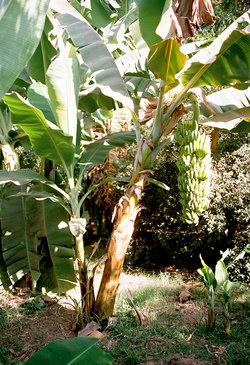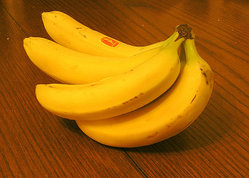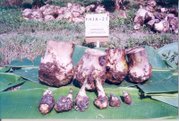Banana
A banana plant is a herb in the genus Musa, which because of its size and structure, is often mistaken for a tree. Bananas are of the family Musaceae, and closely related to plantains. more...
Globally, bananas rank fourth after rice, wheat and maize in human consumption; they are grown in 130 countries worldwide, more than for any other fruit crop. Bananas are native to tropical southeastern Asia.
The stems grow to 4–8 m tall, with large leaves 2–3 m long. The term banana is also applied to the elongated fruit (technically a false berry of the plant, species and varieties) in hanging clusters, several to many fruits to a tier (called a hand), many tiers to a bunch. Bananas typically weigh between 125–200 g, though this varies considerably between different cultivars; of this, about 80% is edible, and the skin the remaining 20%. The total of hanging clusters is called a 'stem' in the commercial world.
In 2003 India led the world in banana production, representing about 23% of the worldwide crop. The four leading banana exporter countries were Ecuador, Costa Rica, Philippines, and Colombia; accounted for about two thirds of the worlds exports; with each exporting more than 1 million tons. Ecuador alone provided more than 30% of global banana exports according to FAO statistics.
Bananas are classified either as dessert bananas (meaning they are yellow and fully ripe when eaten) or as green cooking bananas/plantains. Almost all export bananas are of the dessert variety; however, only about 10-15% of all production is for export, with the US and EU being the dominant buyers.
Bananas and plantains constitute a major staple food crop for millions of people in developing countries. In most tropical counties green (unripe) bananas used for cooking represent the main cultivars. Cooking bananas are very similar to potatoes in how they are used. Both can be fried, boiled, baked or chipped and have similar taste and texture when served. Nutritionally one green cooking banana has about the same nutritional and calorie content as one potato.
The vast majority of producers are small-scale farmers growing the crop either for home consumption or for local markets. Because bananas and plantains will produce fruit year-round, they provide an extremely valuable source of food during the hunger season (that period of time when all the food from the previous harvest has been consumed, and the next harvest is still some time away). It is for these reasons that bananas and plantains are of major importance to food security.
History
The domestication of bananas took place in southeastern Asia. Many species of wild bananas still occur in New Guinea, Malaysia, Indonesia and the Philippines. Recent archaeological and palaeoenvironmental evidence at Kuk Swamp in the Western Highlands Province of Papua New Guinea suggests that banana cultivation there goes back to at least 5000 BC, and possibly goes back to 8000 BC. This would make the New Guinean highlands the place where bananas were first domesticated. It is likely that other species of wild bananas were later also domesticated elsewhere in southeastern Asia.
Read more at Wikipedia.org




